Lake Park’s Bridge Spans History
Why everyone should care about saving the Olmsted-designed bridge.
Do Milwaukeeans care about their Frederick Law Olmsted-designed parks and the current and potential value they offer? If the answer is yes, the debate about preserving the elegant Ravine Road Bridge in Lake Park deserves the attention of every concerned citizen.
Milwaukee County officials want to demolish the iconic bridge without the evaluation required by the National Register of Historic Places. Both the bridge and Lake Park are listed in the National Register. The caprice and expediency by which its removal is being pursued should be a concern to all citizens who care about Milwaukee County’s historic park. Whether you are a bicyclist, runner or weekend wanderer, the integrity of your park system is at risk.
And this is not just any ordinary park system.
Milwaukee is one of a handful of cities with a network of complementary parks designed by Frederick Law Olmsted, the great landscape architect and co-designer of Central Park. Other Olmsted park systems are in Brooklyn, Boston, Buffalo, Louisville and Rochester, New York. His sons’ legacies are showcased in systems from Baltimore to Seattle.
Designed in 1905 by renowned Milwaukee architects George Bowman Ferry and Alfred C. Clas the bridge is an extraordinarily graceful example of Modernist design and technical prowess. According to a Wisconsin Department of Transportation report, it is possibly America’s first concrete arch bridge using the Kahn trussed-bar system of reinforcement—later an industry standard in structural engineering.
In many ways the debate unfolding over Ravine Road Bridge is nothing new in the history of America’s great public parks. Olmsted himself had to fight battles to protect the integrity of parks he designed from unscrupulous and thoughtless actions. In an 1870 address he placed himself on record as not “opposing or undervaluing the advantages of public discussion.” However, he made clear the “danger that public opinion may be led” by individuals seeking expedient solutions to “overrule the results of more comprehensive and impartial study.”
This brings us to the public debate surrounding Ravine Road Bridge today. I do not suggest that Lake Park’s bridge must be preserved without careful considerations to cost and viability. However, I do object to county leaders’ refusal, thus far, to authorize an impartial evaluation of all potential repair options by an engineering firm with experience in preserving historic structures. Only a reputable engineering firm with experts trained in assessing the structure of historic bridges can ascertain if, and how, the Ravine Road Bridge could be effectively preserved.
I have worked with significant historic bridges from New York to Hawaii. After fully addressing concerns by local officials about safety and cost, qualified historic-bridge engineers developed solutions to maintain those bridges’ structural and historical integrity. Each remains a cherished treasure today—and the repairs cost less than a comparable replacement. The Ravine Road Bridge is already one step ahead in this process. In 2016 the City of Milwaukee’s Historic Preservation Office thoroughly documented the historical relevance of this bridge and park in an excellent report: Ravine Concrete Arch Footbridge at Milwaukee Lake Park: A Cultural Heritage Assessment Study and Report.
Moreover, in an era of tight budgets, it’s concerning that Milwaukee County does not intend to seek federal grants (for which this bridge is eligible) that could finance 80 percent of the project. If officials do not comprehend the value of retaining this historically significant bridge and park, or seek available funding for its preservation, it’s up to citizens to demand that public stewards look out for Milwaukee’s park users and the integrity of the city’s Olmsted parks.
Due diligence requires that county leaders engage in an objective analysis of all potential preservation solutions before determining the fate of this important structure. Then, and only then, can the community make an informed decision about the Ravine Road Bridge in Olmsted’s great Lake Park.
Ravine Road Bridge in Lake Park
Paul Daniel Marriott, on behalf of the National Association for Olmsted Parks.
Paul Daniel Marriott, PhD. is a member of the Board of Trustees for the National Association for Olmsted Parks. A Washington, D.C.-based landscape architect, Marriott is also a widely-published author specializing in historic roads. The National Association for Olmsted Parks (NAOP), established in 1980, is a coalition of design and preservation professionals, historic property and park managers, scholars, municipal officials, citizen activists, and representatives of Olmsted organizations around the U.S. Its concern is the legacy of landscape work left by Frederick Law Olmsted Sr. and the firm continued by his sons. NAOP is the only national organization solely dedicated to preserving this legacy by providing the advocacy, research, and education needed to protect, restore, and maintain these exemplary parks and landscapes.
More about the Ravine Road Bridge Project
- City Should Enforce Reopening of Ravine Road, Park Friends Say in Filing - Lake Park Friends - Sep 28th, 2023
- MKE County: Ravine Road Debate Heats Up - Graham Kilmer - Aug 14th, 2023
- MKE County: Ravine Road Project Could Begin in 2024, With Pedestrian-Only Option - Graham Kilmer - Aug 1st, 2023
- MKE County: Lake Park Bridge Open For First Time In 6 Years - Graham Kilmer - Oct 29th, 2022
- Friday Photos: Lake Park Bridge Overhaul Nears Completion - Jeramey Jannene - Sep 23rd, 2022
- MKE County: Lake Park Bridge Needs $1 Million More - Graham Kilmer - May 18th, 2021
- County Receives $2 Million Grant for Lake Park Bridge - County Executive Chris Abele - Sep 12th, 2018
- County Parks To Seek State Grant to Fund Ravine Road Bridge Project - Milwaukee County Parks - Feb 8th, 2018
- Op-Ed: Lake Park’s Bridge Spans History - Paul Daniel Marriott - Apr 5th, 2017
- Public Forum For Lake Park Bridge - Virginia Small - Feb 13th, 2017
Read more about Ravine Road Bridge Project here

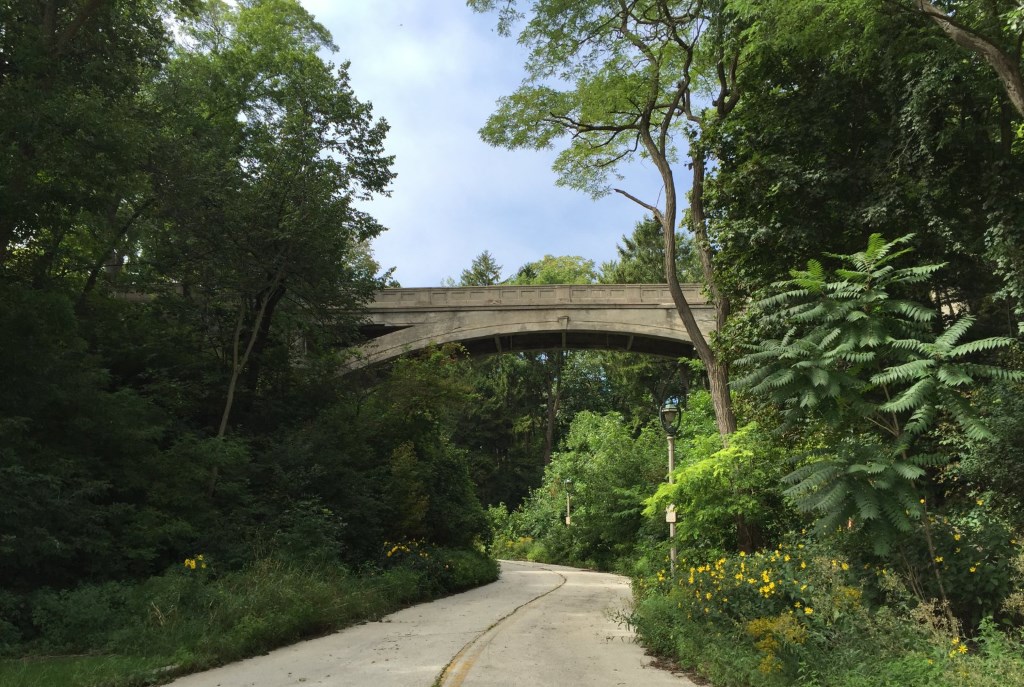
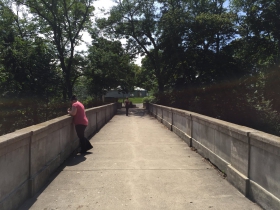
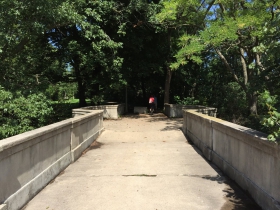
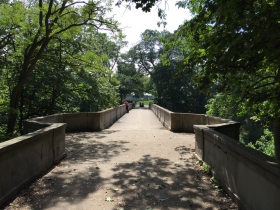
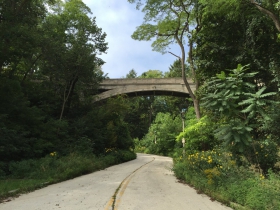
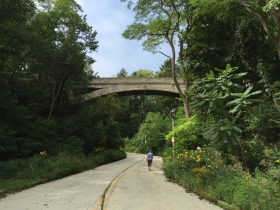
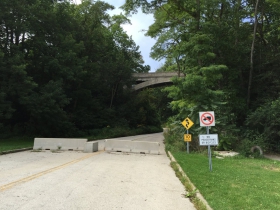
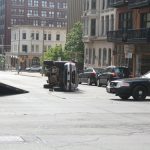












These are treasures and worth our help.
I could not agree more with Marriott’s sentiments in this Op-Ed. Statements such as this one eloquently express the thoughts I have had about the Ravine Road Bridge in the last several months: “…I do object to county leaders’ refusal, thus far, to authorize an impartial evaluation of all potential repair options by an engineering firm with experience in preserving historic structures. Only a reputable engineering firm with experts trained in assessing the structure of historic bridges can ascertain if, and how, the Ravine Road Bridge could be effectively preserved.”
I can only hope that local residents, County Officials, and others who use beautiful Lake Park read this piece and consider it carefully, and also consider the fact that it is written by someone who does not even live in Milwaukee. As locals, WE need to step up to the plate as Marriott has and speak out, and speak up for the Ravine Road Bridge. For further information, I have put together a comprehensive, informative website on the bridge: ravineroadbridge.weebly.com
Restoration of this bridge should definitely be studied. Our elected officials including Sheldon Wasserman and Chris Abele want to simply tear it down and get on with a “look-alike” bridge replacement. There is no good reason to not thoroughly investigate restoration. Follow the money on this one.
Restoration of this bridge should definitely be investigated. The bridge is a park gem. For some reason our elected officials including Sheldon Wasserman and Chris Abele want to tear it down and get on with a “look-alike” replacement. There is no reason restoration should not be thoroughly evaluated. Follow the money on this one.
Great essay! Really like the point of potentially 80% of costs could be secured through federal grants which wouldn’t be available for new proposal.
It doesn’t help that the primary proposed alternative is designed by the chair of the Milwaukee preservation commission. There is a conflict of interest at work that should be exposed.
These observations by Marriotte right on target. Milwaukee had to realize the value in Olmsted designs and the historical significance now and for the future. This park is a gem along Milwaukee’s waterfront, a place that I spent my youth and into adulthood with my children. I thought them about great designers like FL Wright and Olmsted and how lucky Milwaukee is to have a place with this brilliant design contribution. Milwaukee needs to save and restore this public park with its unique infrastructure at all costs!!!!
This lovely, graceful bridge had been used and admired by generations of people. Women in hoop skirts to bike race spectators and everything in between have been charmed by the Ravine Bridge. We as a people need history in art, music, architecture and more to cherish what came before us and made us who we are. Please carefully evaluate the saving of this bridge. Once this piece of history is gone……
This article is misleading. There has been a long and thorough process of evaluating the alternatives for the bridge, which is greatly valued by our community. The community was included in that process and quite a few community meetings were held to go over alternatives. Several involved repairing the bridge, with consultants’ proposals explained in detail. None of those was either aesthetically pleasing or cost effective. They did not do justice to the design of the bridge. If a proposal for repair was available which did not detract from the appearance of the bridge, would be economically feasible and would last as long as reconstruction, I would imagine the community would embrace it.
Given the options that were presented, the community opted for reconstruction to the original design specifications, with a few minor modifications to accommodate modern requirements. It was felt that the real value of the bridge was in its design, not in the particular concrete that it was made of. This is not a material that cannot be duplicated today, nor is the workmanship something which is not available today. In addition, reconstruction is a valid historic preservation option, according to the National Park Service. No attempt would be made to present it as the original bridge; it would bear a plaque stating that it is a reconstruction.
This decision was made by the community, not hastily and not without lengthy debate. The funding for the chosen option is now in place. That funding includes a large private donation, which is specific to this option. The federal grant money which is available is highly competitive and the application process would delay the project several more years at least. In fact, the private donation is likely as great or greater than any grant would be and likely would be lost.
Dear Tom: provide the money on this one so we can follow it.
I vote for replacement and sell chunks to historic concrete lovers. Are we 3 years into this blistering controversy?
An expert has spoken, AND does the value of the Olmsted design show up somewhere/somehow on the books of the city or county? “Creative accounting” technique is featured among most of the posts on this site.
The esthetic opinion of past hired and elected employees hasn’t helped in recurring eras when the park has been neglected. (Yes, neglected.)
Bridge plans from July 1895 over both Lake Park ravines pre-date Olmsted (The images were published in Milwaukee’s German language newspapers, maybe others too. Check mpl.org’s “19th Century US Newspapers” site.)
The location of the light house helps with bearings in the image from the era before landfill improvements. I’ve no idea if those bridges were built, then replaced by the Olmsted project.
https://www.facebook.com/photo.php?fbid=839868022821771&set=o.190247763021&type=3&theater
Barbara, it’s odd that you would call an opinion piece written by Paul Daniel Marriott, PhD misleading. I don’t really understand how an op-ed written by a member of the Board of Trustees for the National Association for Olmsted Parks can be as easily dismissed as you dismissed it. It would be difficult to find someone locally who is better qualified to offer his/her opinion on the Lake Park Ravine Road Bridge.
As I understand it, the large private donation is NOT specific to replacement. It is only specific to closing the road underneath the bridge. I’m also very curious to know why the National Park Service was included in this decision process. What do they have to do with Lake Park, or any of this?
I’m not opposed to a replacement, once all other avenues have been explored, by REPUTABLE and EXPERIENCED historic engineers. I would like to know what firm would be reconstructing this hypothetical bridge replacement with the same workmanship that was used in the early 1900s. I would also be interested to see this firm’s design portfolio containing other similar projects. I would also like to know what modifications the phrase “a few minor modifications” is referring.
Have you researched the federal grant money enough yourself to know that the application process would delay the project several more years at least? Or, were you simply told that by somebody who was trying to hurry up this whole thing?
I mean no ill will. Your comments just brought up a lot of questions that I’d like to know the answers to. I was not involved in the “long and thorough process” that you refer to in your first paragraph. Thanks!
Carlos, I totally agree with you that the chair of the Historic Preservation Commission should not be the designer of a replacement bridge. That is absolutely not what is being proposed. The proposal that was accepted by the community and is supported by Supervisor Wasserman is to rebuild the bridge using the original Ferry & Clas plans.
The chair of the Historic Preservation Commission does, however, have a talk coming up at the Lighthouse, the title of which implies that he is going to be displaying his own designs for bridge replacement. I find this highly inappropriate at this time, as the community has gone through a rigorous process of selecting the proposed alternative and he was part of that selection process.
Carlos, I completely agree that the chair of the City’s Historic Preservation Commission should not be designing any bridge replacement. However, that is NOT what is being proposed. The proposal is to rebuild the bridge using the ORIGINAL Ferry & Clas plans, which are still available.
Oddly, and quite inappropriately, the chair of the Historic Preservation Commission has a talk coming up at the Lighthouse wherein, according to the title of the talk, he plans to re-present his own plans for the bridge. He was part of the very rigorous process that the community undertook to select an option for bridge repair or replacement and presented his plans then to the community. They were rejected more than once.
Incidentally, I’d like to know how many of the people expressing outrage at the community’s decision actually took the time to attend the numerous meetings that were held to discuss all the possibilities that were before us. I know that the person who wrote this highly misleading article was not there. He is working from secondhand information.
Carlos, I completely agree that the chair of the Historic Preservation Commission should not be designing the bridge replacement. It is a clear conflict. However, this is NOT the option the community selected. He presented his designs to the community during some of our numerous meetings to consider all the options and they were not selected. The option that was selected was to rebuild the bridge according to its original Ferry & Clas plans.
Oddly, and I believe inappropriately, he is scheduled to give a talk at the Lighthouse to re-present his plans. At least, that is what the title of his talk alludes to. The motivation for this is unclear, as the community has already selected its preferred option by a considerable majority.
Incidentally, I’d like to know how many of the people who are up in arms about the proposal finally selected attended those community meetings and took part in making this difficult decision? I can assure you that the author of this article did not. The article is based on hearsay.
This website seems to be having problems updating. I’ve tried three times to post a response to Carlos. I see in my email that Rebecca Silber has responded to my first post. It doesn’t show up on the site yet but I’m going to try to respond to it now anyway.
Rebecca, I say the article is misleading not because the author isn’t qualified but because he is clearly working from hearsay, and that from someone who does not like what the community decided by a large majority of those present (and these meetings were standing room only). He clearly thinks the option selected did not include the community and was rushed. It did, and was not.
Were you present at the meetings? An individual from the Wisconsin Historical Society attended one at which available grants were discussed. I don’t know why you would think that the County wouldn’t want to apply for grants if there was a decent chance of obtaining one. It’s the community that wants something done about the bridge as soon as possible, more than the County.
No, I don’t know that the person who offered a million dollars for the project didn’t care what happened with the bridge as long as the road was closed to traffic. I doubt that would be the case. You’d have to ask that individual, who at this point prefers to remain anonymous. It is true that the individual did not come forward until the final proposal had been selected.
What the National Park Service has to do with this is that the park’s historic designation is granted by the National Park Service. They have clear guidelines for historic preservation and yes, reconstruction is one. What personal expertise I have is as a masters degree urban planner who studied and has a particular interest in historic preservation. And yes, reconstruction is a valid solution for historic preservation where warranted. Given the options that the community considered, it is very much warranted.
As I already stated, if there is another option which is aesthetically pleasing (that is, does not alter the appearance of the bridge) and will be cost effective, I would love to see it and I’m sure the rest of the community would, too. I have neither seen nor heard of any repair options which will extend the life of the bridge more than 25-40 years at best. All will cost as much as or more than rebuilding, which should last easily another 80-100 years.
I know that according to historic preservation chapter and verse, one never takes cost effectiveness into consideration. However, this is the real world we are living in. If a repair only lasts 25 years, it will be necessary then to start all over and figure out how to find funding once again. And a repair would almost certainly have to be paid from the county’s annual operating budget, not from bonding (borrowing), which is easier to obtain because of its lesser impact on the annual budget. Reconstruction would qualify for government bonding. Part of the funding which is already lined up for the replacement is in bonding.
Barbara, I agree wholeheartedly that the talk coming up at the Lighthouse is completely inappropriate.
For the replacement route, who are the engineers are architects that have been selected to replicate the original design? What other concrete bridge work have they done? I’d feel better about this if I could see samples of similar work that the selected firms have done for other clients.
To answer your question, I only attended the meeting in February. Admittedly, I came into this late. I have personal opinions, but am also trying to remain open-minded and just get my questions answered. I appreciate your knowledge.
Also to your point above, I wish that Marriott had been invited to all of these meetings. It would have been interesting, and perhaps helpful, to hear his insights firsthand. Is it possible to bring any Olmsted experts in?
Here are some relevant excerpts from the federal standards Barbara noted as well as local protocols in effect:
Replacing Deteriorated Historic Materials and Features (from NPS Standards, p. 64): https://www.nps.gov/tps/standards/fourtreatments/standguide/rehab/rehab_approach.htm
“Following repair in the hierarchy, Rehabilitation guidance is provided for replacing an entire character-defining feature with new material because the level of deterioration or damage…precludes repair…While the National Park Service guidelines recommend the replacement of an entire character-defining feature that is extensively deteriorated, they never recommend removal and replacement with new material of a feature that—although damaged or deteriorated—could reasonably be repaired and thus preserved.”
The main portion of the Ravine Road Bridge’s original fabric (its defining concrete arch) remains structurally intact, according to Graef’s report. NPS protocols indicate that Rehabilitation would be appropriate–rather than demolition and Complete Reconstruction, in which no original fabric would remain.
Reconstruction may be considered an accepted preservation treatment but only if it meets very specific criteria and would “retain the property’s integrity.”
City of Milwaukee Historic Preservation Commission (HPC) will also review plans and must approve a Certificate of Appropriateness, since the bridge is in a historic district. Milwaukee HPC on Preservation Process: “First and foremost, preservation of historic resources is the ultimate goal of having gone through the National Register process and local historic designation process. It makes no sense to think of a historic resource as expendable or historic only if it is convenient…Demolition is the last resort and all efforts must be made to repair and retain the resource so that it can continue telling the story of its significance.” Statement by Carlen Hatala, City of Milwaukee Historic Preservation Commission planner, 9/1/16
Any demolition plan must comply with the Milwaukee’s Historic Preservation Ordinance (320-21-11-h) and address “whether the structure is of such architectural or historic significance that its demolition would be detrimental to the public interest…” Demolition could be determined to create an “adverse effect” on Lake Park. According to preservation protocols, if the “historical significance” of the Ravine Road Bridge is lost, it would diminish Lake Park’s “historical integrity.”
https://www.nps.gov/nr/publications/bulletins/nrb15/nrb15_7.htm#crit con e
Coming late to this, I am reassured by Barbara’s comments. From a restoration ecologist’s point of view (plants) I feel the bridge is so overgrown at this moment that the original design cannot be appreciated anyway.
Wendy,
As you may know, there have been sustained restoration ecology efforts throughout Lake Park for at least 20 years (thanks to the Lake Park Friends Nature Committee, which meets weekly to attend to that and other goals). Working in concert with County Parks staff, they have made a big impact overall, especially in reducing noxious invasive plants–an ongoing battle.
However, since the road was closed more than two years ago it appears that little or no maintenance of any type is being done. So it’s become somewhat of a ruin–at least for now. However, whether the bridge is replaced or restored, it’s been publicly stated that either project will require the removal of many plantings in the vicinity to be able to do the job.
Virginia, I had already reviewed the same National Park Service language that you are citing. I think the operative word is “reasonably” — as in “a feature that—although damaged or deteriorated—could reasonably be repaired and thus preserved.”
As I have stated more than once, if a way to repair the bridge can be found that will not have aesthetic problems and will make the structure sound for a long enough period of time to justify its cost (and the fact that it would likely have to be paid out of the operating budget — not borrowing — to the extent that it cannot be covered by grants) that would likely be fine. Anything less would not be “reasonable.”
Wendy, I very much agree that part of any repair or replacement needs to be removal of all the growth that now obscures much of the bridge’s design.
Barbara,
Thanks for clarifying. I guess that’s why historic preservation officials get involved to help sort through these complex issues.
What is your source for this statement?
“and the fact that it (rehab repair) would likely have to be paid out of the operating budget — not borrowing — to the extent that it cannot be covered by grants.”
Couny officials have said that short-term “patch” repairs (such as protective mesh) must be covered by operating. But I’ve not seen anything saying that long-term rehab/restoration could not be funded through borrowing.
Milwaukee Native,
As a rule, repairs are covered by operating funding, and construction is covered by capital borrowing. Of course, debt service on bonding does come out of operating funding, but this has less of an annual budget impact.
I was a fiscal analyst for the City of Milwaukee Common Council and worked on analyzing the City budget. Governmental entities, in order to keep their bond ratings high and interest rates low, bond only projects with a very long life expectancy (25 years is not very long) and a high enough cost to justify bonding. In other words, borrowing is considered a last resort.
When I was at the City, repairs were not to be bonded. So, as I said, repairing the bridge would “likely” be expected (by the County Board of Supervisors) to come out of operating funds rather than borrowing.
“Olmsted himself had to fight battles to protect the integrity of parks he designed from unscrupulous and thoughtless actions.”
Thanks for your “from-a-distance” views, Mr. Marriott.
I attended the Feb 15 meeting and was one of the large majority that voted for the fiscally responsible, “duplicate-replacement” option that is being pursued. I don’t consider myself guilty of “unscrupulous and thoughtless actions.”
Asking for the third time, in case (in the hope that) someone commenting knows the answer:
If the bridge is replaced, WHO has been selected as the architect and engineer to replicate this early 1900s design? Do they have a portfolio containing examples of other concrete bridgework that the community can view?
The contractor won’t be chosen until the project has been approved by the City’s Historic Preservation Commission and the County Board of Supervisors. Then it will be put out for bids. If the Request for Proposals is specific on the matter of experience in concrete bridgework then the contractor selected will have that expertise. It is pretty much unthinkable that the County would select a contractor who did not, unless it wants to be on the hook for correcting bad work.
Rebecca,
Re: your question about who will design a replica bridge, GRAEF has been selected–as the second phase of their contract to design replacement bridges.
Here’s background about their bridge work: http://www.graef-usa.com/our-work/services/services-transportation
In November 2016 GRAEF requested a $50,000 fee increase (from $90,000 to $140,000) to draft construction drawings for a replace-in-kind design based on the original 1905 bridge drawings. Their fee-increase request cites: “more historic coordination, a public information meeting and additional detail sheets.” GRAEF’’s original Phase 2 bid had “assume[d] replace in kind” solution.
County administrators signed off on GRAEF’s $140,000 request (including the $50,000 fee increase) to draft construction drawings. However, in December 2016 recommended that the board NOT approve it, pending resolving some issues about the contract and funding.
GRAEF’s contract may be resubmitted to the county board, which could actively review it or “passively” allow approval without discussion, depending on some procedural issues.
Here’s the video and related files from when it was presented in committee (County File 16-733).
https://milwaukeecounty.legistar.com/LegislationDetail.aspx?ID=2896464&GUID=69E5DB3F-118D-4484-A7F8-1C6E84454EF9&Options=&Search=
As Barbara noted, a separate RFP will be issued for a construction contract, presumably after a proposed design gets approved at various levels.
Thanks, Virginia. If the County Parks Department has signed off on the Graef contract for architectural drawings but the Board of Supervisors has not yet, it is not final that Graef will do the drawings. It is certainly highly likely, but not a foregone conclusion. I have no reason to believe Graef couldn’t do a competent job on the drawings.
I have to apologize. I was assuming that the County followed similar rules to the City on capital bonding. The County’s Capital Budget document sets out their guidelines. While it is true that operating costs cannot be bonded, this is defined as work that has less than a one year life; in other words, work that would be repeated each year. Therefore, repairing the bridge instead of replacing it would not be considered an operating cost and could be bonded.
Barbara, thanks for info on funding for operating versus repairs.
The Fee Increase Approval (linked below) has been signed off not just by Parks but also heads of Administrative Services, Architecture/Engineering, Corporation Counsel, and Facilities as well as the Comptroller and County Executive.
GRAEF’s original contract did not specify any Historical Coordination for Phase 2 of this project, even though the bridge is historically designated by the city and the National Register. As such, any treatment will require review by the city and state preservation offices. Demolition of a designated resource is generally deemed an “adverse effect” requiring such “mitigation,” which must be negotiated.
Heritage Research, LTD, headed by John Vogel, who participated in Phase 1 planning, would coordinate that process. GRAEF’s proposal says this might involve research for “1-2 display panels at one end of the bridge” interpreting the historical significance of the original bridge. “Heritage Research’s goal would be to meet the State Statutes regarding the removal, replacement, documentation and mitigation of the existing bridge if Federal funds are not used in the project.” The consultant “will also focus on what mitigation might be needed in order to remove the bridge, specifically working first with the State Historical Preservation Office.” The City of Milwaukee Historic Preservation Commission also would have to approve demolition.
GRAEF also did not include any Public Involvement Meeting to present final drawings in their original RFP bid. Those two items plus “a number of additional detail sheets” are what will cost $50,000 more. GRAEF’s proposed contract notes that “it’s not expected that comments received at this meeting will change any work already performed.” (Sounds like any changes will incur higher fees.)
The Fee Increase doc notes that “plans will be drawn for Milwaukee County to bid the project’s construction without using ‘Federal or State’ money. If Federal or State money is available and deemed an advantage to funding of the project it is required that the design process must be managed by the Wisconsin Dept. of Transportation or their representative (DAAR Engineering).”
Additional reports could be required if the project received Federal or State funding and GRAEF would charge extra to produce them.
County File: https://milwaukeecounty.legistar.com/LegislationDetail.aspx?ID=2896464&GUID=69E5DB3F-118D-4484-A7F8-1C6E84454EF9&Options=&Search=
Video: http://milwaukeecounty.granicus.com/MediaPlayer.php?view_id=2&clip_id=1245&meta_id=288713